I’m an avid cyclist. I raced in college, and I still take my college bike on my cruising cat and just hang it on a rack on the stern rail. At Practical Sailor, we’ve looked at folding bikes in the past and touched on e-bikes and e-bike conversions, but it’s high time for an update. While I’m quite happy with a “push bike” as the Brits call it, we know that many people, especially older sailors, will want a little more help going up hills. Enter the e-bike.
There are several classes of e-bikes. A Class 1 e-bike only uses pedal assistance and has a max speed of 20 mph. With regards to traffic rules in most jurisdictions, a Class 1 e-bike is considered a bicycle.
A Class 2 e-bike uses pedal assistance and an accelerator (throttle). It also has a max speed of 20 mph. Although most places treat these the same as Class 1 bikes, some jurisdictions prohibit their use on certain bike trails.
Class 3 bikes can go up to 28 mph, require a helmet to ride, and are generally excluded from bike paths (you can use the bike lane or ride on the road). Most Class 3 e-bikes get around the bike path prohibition with a switch that limits speed. If you keep your speed under 20 mph on the local bike path, you probably won’t get into trouble.
Aside from getting you there quicker, an e-bike’s ability to sustain 20 mph makes it easier to keep pace with traffic in urban environments.
POWER
A power range of 350–500 watts is standard for Class 1 and Class 2 bikes, enough to whip you along at bicycle speed. For comparison, a fit racing cyclist can deliver about 250–300 watts to the wheels for about 30 minutes. Greater than 500 watts of power is more than you can safely use on anything that still looks like a conventional bicycle.
Folding bikes may have only 250–350 watts, and this is acceptable because a bike with 16- to 20-inch tires becomes unsafe above 15 miles per hour. Many 16-inch e-bikes are governed at this speed. For safety reasons, we don’t recommend e-bikes with wheel diameters smaller than 16-inches.
RANGE
Range is a function of amp hours (Ah). A higher voltage battery will deliver more power per Ah (Watts = Ah x Volts). Assuming you have a battery of 36–48 volts, and you operate with pedal assist—your range will be about 1–1.5 miles per Ah, depending on speed, terrain, and weight.
So with a 36-volt, 500 watt battery you can count on about 20 miles, but you will get greater range with pedal assist, or riding at modest speeds (15 mph or less) on flat terrain. All of the bikes have a charge indicator, but how far that will get you depends on the terrain.
Manufacturer range ratings are generally optimistic when compared to actual use patterns. Because most e-bikes are inefficient pedal bikes and going fast is fun, most riders rely more heavily on the electric boost than the makers’ estimates assume. As a result, most users get less range than they hoped for. In the adjacent table, the bikes with the greatest number of watt-hours should deliver the longest range.
WEIGHT
Conventional bicycles and 20-inch folding bicycles weigh about 20–30 pounds. Add a battery, motor, wiring, controls, fat tires, a fat seat, a big rack, and heavy frame and, in our opinion, you no longer have an electric bike—you have an electric moped. Presumably you want a bike to put on your boat, and over 45 pounds will be difficult to lug aboard without help. The lightest bike we looked at, the 20-inch folding Dahon Mariner, is about 27 pounds. Heavier e-bikes can weigh twice that.
HUB DRIVE VS. MID-DRIVE
Rear hub drives feature a large rear hub with a built-in motor. Mid-drives attach to the bottom bracket and drive through the chain and sprocket train. Because a mid-drive takes advantage of the bike’s gearing system, they offer more power for steep hills. The mid-drive Montague that we tested would go up anything the tire would stick to with little effort.
A mid-drive places more strain on the chain and drive train, and a hub drive potentially puts more strain on the axle. Both are trouble-free when properly engineered. (All of the e-bikes we looked at were well designed to handle the higher loads.) A mid-drive provides a more natural feel, and you will still go through the gears for hills as you normally would. Hub drives are simpler to retrofit, less expensive, and still strong enough to climb modest hills.
SPOKES, SPROCKETS, AND FIT
A hub drive puts more strain on the spokes, though probably not much more than a young, aggressive rider. Look for e-bikes with 12-gauge spokes, rather than the 14–16 gauge spokes seen on lighter bikes.
Most e-bikes have only one front sprocket, and five to eight different rear sprockets (speeds). Although not in the same league as your lightweight touring bike’s 18-speed setup, the e-bike’s gearing is adequate for hitting 20 mph in the flats and for grinding up hills.
Many e-bikes have smaller wheels and frames than conventional bikes. Because fit is important, and because you best know your needs, we recommend you find store dedicated to e-bikes, and test ride a few different types. Riding an e-bike is different from riding a regular bike, so you want to experience it for yourself. Traditional bike shops are not your best bet; they tend to specialize in full size e-bikes, and the prices (more than $4,000) may take your breath away.
CONVERSION KITS
You can probably buy a factory-made compact or folding e-bike for less than it costs to convert the bike you have. Unless you really like your current conventional bike, you’re better off exploring the myriad of choices in e-bikes.
We chose to convert my wife’s tadpole trike, a low, recumbent tricycle with two wheels in the front. She needs three wheels because Menier’s disease has disrupted her sense of balance, and several knee surgeries have made it painful for her to ride, especially up hills. An electric trike would have served her well, but she really likes her current trike, so an e-bike conversion made the most sense and ended up saving us quite a bit of money.
There are three types of motors for conversion kits—rear hub, front hub, or mid-drive. The mid-drive takes advantage of the bike’s gearing system, but we chose hub drive for simplicity.
To accommodate my wife’s limited range of motion, we replaced the trike’s 170 mm cranks with 151 mm cranks. The 170 mm length common on many adult bikes is optimized for 5΄9˝ men, so shorter riders might want to consider reducing the crank length if they expect to do a lot of pedaling. Cranks of 160–165 mm are a common retrofit. Although shorter cranks will reduce your leverage, they are easier to pedal fast, so many riders won’t notice any loss in power. Shorter cranks are available for most bikes and e-bikes.
It took about an hour to install our Bafang kit. The installation required no special skills or tools, other than a freewheel wrench (about $8). The kit was designed for a mountain bike, but with a few small changes, it worked well on the trike. A range of wheel sizes are available. The kit included a new rear wheel, built with heavier spokes and rim than stock. You reuse your existing bike’s tire and freewheel (sprocket assembly).
BIKE CHOICES
The range of bikes and the niches they fill are even broader than conventional bikes. We tested several different types and found something to like in each of them. Although we focused on folding e-bikes, we included one conventional bike, one non-folding e-bike, and a non-pedal e-bike for comparison.
FUJI ACR 2.0
Our representative for conventional bikes, the Fuji ACR is a low-end carbon/aluminum racing bike. It is out of production, but you can find it or comparable model in good condition on the used market for less than $500. The big advantage of an entry-level racing bike is its light weight. It is about half the weight of an average e-bike. If the bike is fitted with click-in cleats on the pedals, a fit rider can move as fast as a Class 2 e-bike on flat terrain. No, it does not fold, but quick-release hubs make it easy to take apart and arrange in a package that occupies no more space than a full-size folding bike.
DAHON MARINER D-8
Among the most common folding bikes used by cruisers, the time-tested Dahon Mariner is compact and lightweight. As on all bikes of this size, the 20-inch wheels make for a bumpy ride on rough roads. It’s less stable than a conventional bike, although you may not notice this unless you are descending a steep hill.
Bottom line: Weighing 10 pounds less than any e-bike we tested, the Dahon Mariner is an affordable folding bike option that will serve as a grocery-getter. Recommended.
ZIZZO LIBERTÉ
One of several models offered by California-based Zizzo bikes, the Liberté is very much like the Mariner, but with cheaper parts. Zizzo also makes an upgraded rust-resistant model, the Marino, which we did not test, but is probably worth the upgrade for a full-time cruiser. The Liberté folds and unfolds quickly—good for multi-mode commuting. Rinse it after use, and keep the chain, gears, and cables well-oiled.
Bottom line: With some care, the Liberté will do fine on a boat. We rated it a Budget Buy.
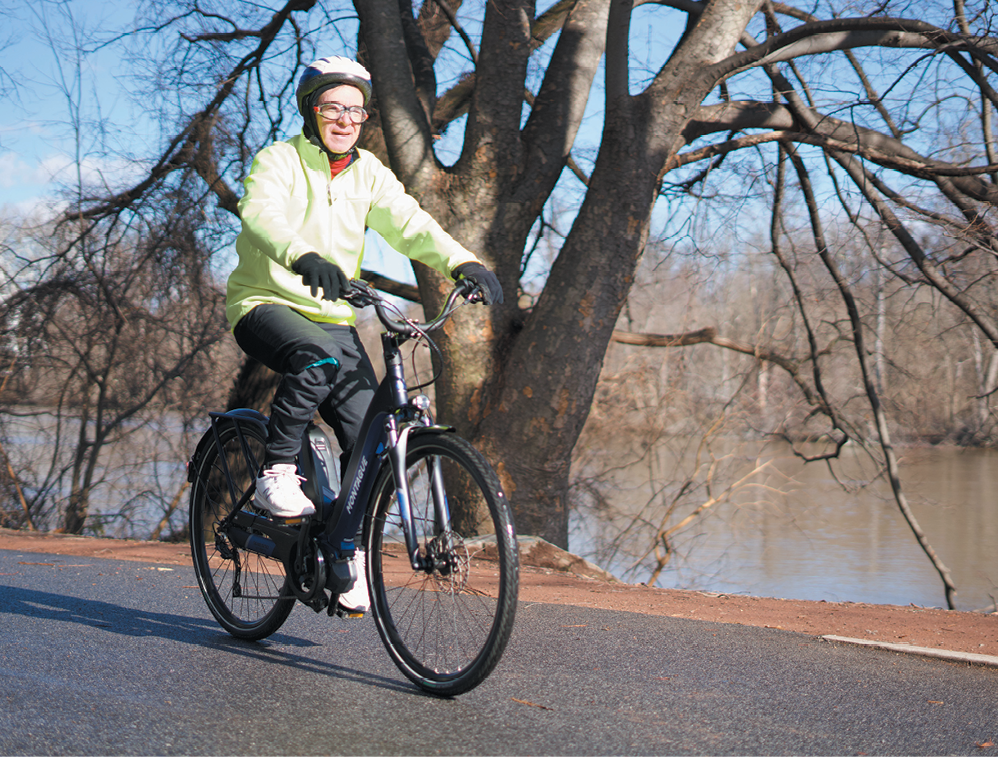
CONVERSION KITS
If you are dead set on keeping your pedal bike, there are several conversion kits to choose from. Some offer specialized features that you might prefer. We chose Bafang because the company has a good reputation and is well-established in this market.
BAFANG HUB KIT
Bafang is the best known among conversion kits. We picked a large 816 Ah battery size and a powerful 500-watt motor because the trike we were powering was heavy. The kit includes sensors to deactivate the drive if the pedals are not moving or if the brakes are applied. We disconnected the pedal sensor, allowing us to power the bike home without pedaling. Bafang offers a range of display models. All provide the basic functions—speed, remaining charge, and a way to control the amount of boost. Other display options include a smart phone app that will allow you to operate the boost kit while also using a navigation app all in one device. Installing the system, including the basic 500c display ($70) took about an hour.
Bottom line: The large battery provided the greatest range of any bike in our review. We gave it a Recommended rating for a mountain bike, trike, or a similar full-size bike that you want to power.
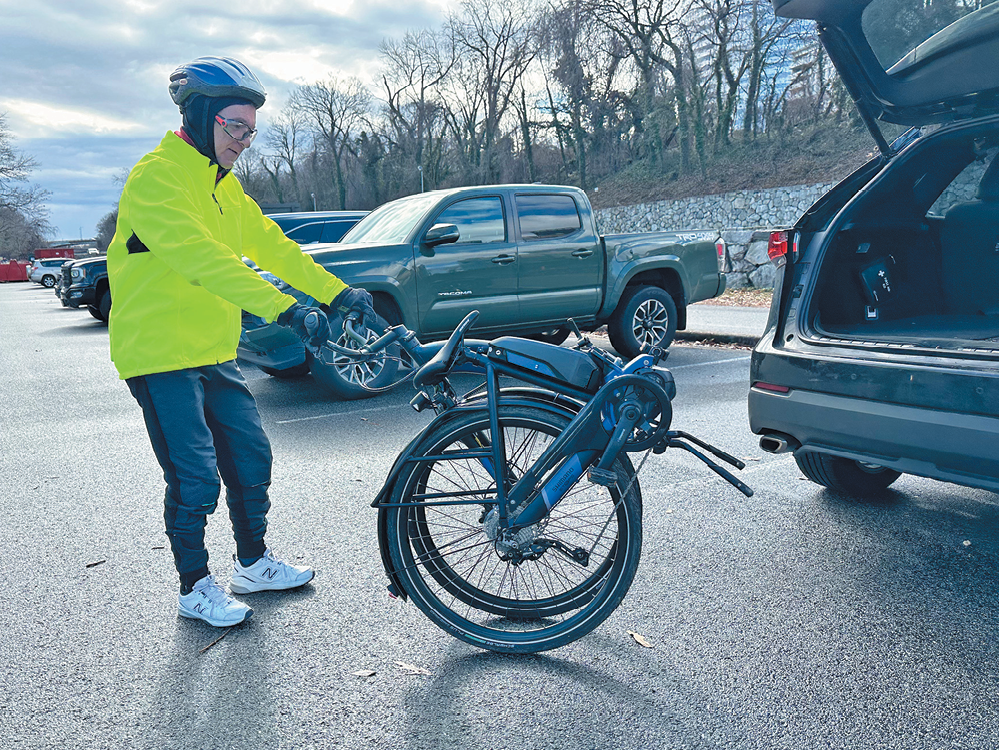
BOSCH TRIKE BOOST KIT
The dealer offered us a kit for $2,850 plus installation, more than five times the price of the basic Bafang kit. Comparing the two is apples to oranges, but it’s still hard to justify the price, unless you really love your current ride. We tried the mid-drive conversion, which provided a silky-smooth proportional boost through a very simple and intuitive interface.
Bottom line: You won’t go wrong with this high-end conversion. We rated it as Recommended, but only for the deep-pocketed rider who can’t let go of their favorite bike.
ZIZZO E-BIKE CONVERSION KIT
Have a folding bike you like? For $500 you can electrify it. This rear-hub kit looks a lot like the Bafang kit and presumably performs similarly. It’s a little heavy, so your conversion will approach the weight of Zizzo’s 42-pound folding electric e-Forte ($1,000).
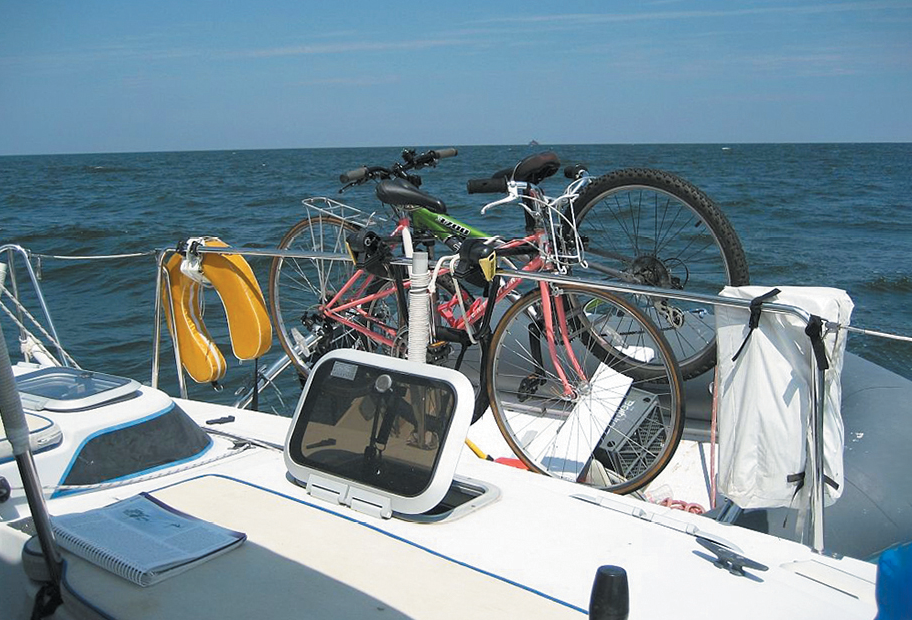
Bottom line: This is a decent kit, but we’d recommend the Bafang, since conversions are their specialty. If you don’t already have folding bike, consider the e-Forte.
FOLDING E-BIKES
As a rule, e-bikes are both heavier and bulkier, even folded. To compensate for the added weight, some folding e-bikes use smaller 16-inch wheels—a bad trade-off if stability and a smooth ride is your priority.
DAHON K-1
We tested the 16-inch version, which provided a choppier ride and was less stable steering than the Dahon 20-inch pedal-only Mariner. The owner of the bike we tested, however, was enthusiastic about the advantage of the electric motor, and praised the bike’s reliability.
Bottom line: We rated this bike as Recommended for basic transport. It comes from a well-established maker of folding bikes, so parts should be readily available.
MONTAGUE MT-1
With a Shimano E6100 mid-drive system and a Shimano Deore crankset, the Montague rode like a good bike. The brakes are crisp, it shifts easily, and it’s as stable and predictable at high speeds and across soft and rough surfaces as any full-size bike. With the boost turned off, it pedals as well as any similar weight bike. The display is small and simple, but it gives you speed, boost level, and remaining battery life, which is all you need.
Bottom line: Although a little heavy, the Montague is a bike you can ride fast and far. Recommended.
AVENTON SYNCH.2
We’d seen a couple local riders with these tank-like bikes on the bike path, so we asked if we could give one a whirl. The owners found the fat tires very comfortable and the range acceptable, while admitting that they keep the boost on high and don’t pedal much. At 68 pounds, the Aventon is more than triple the weight of our representative road bike. We’d want help lifting it onto the boat.
Bottom line: We had trouble heaving it into our car trunk. Unless you are stuck on land, oversized e-bikes of this style are not a good choice.
JUPITER DISCOVERY X5
We encountered several Discovery e-bikes on the local bike path and were able to put one through its paces. Like all 16-inch wheel size bikes that we tested, it could have been more stable, but frequent riders say they soon become accustomed to the smaller dimensions. The small wheel size is not advisable for riding at high speeds, but it is fine for around-town commuting.
Bottom line: A compact around-town rider at a competitive price. Recommended.
QUALISPORTS VOLIDOR
Although we did not test this bike, we included it after seeing it stowed on a local boat. The battery is hidden in the seat post, creating an elegant, compact design. It seems well made, weighs less than 40 pounds, and folds into a compact package. The owner had been using it for about a year and considered it reliable.
Bottom line: Not tested. The seat-post battery design is interesting. The 7Ah battery will limit range.
ZIZZO E-FORTE
Although we didn’t ride this bike, it is based in the Zizzo Liberté, which we did test. We expect it will ride like a folding bike with a basic hub conversion kit, which is to say it will be practical and reliable. It’s on the lighter side but is still nearly twice the weight of our example pedal-bike.
Bottom line: Modest range, good price, and compact design. Recommended.
NON-FOLDING E-BIKES AND SCOOTERS
As with any new product category, the e-bike field is still evolving. Although most non-folding e-bikes on the market would be a bear to stow on a boat, a couple non-folding designs caught our eye before we went to press.
VELOTRIC T1-ST
Though this bike doesn’t fold, it is economical and relatively light, and has a clean design that integrates the battery pack and wiring into the frame. It rides like a regular bike, something that few folding bike fully accomplish, with 30 percent less weight than the Montague. The 9.8 Ah battery is a little on the small size, and we noticed drag when peddling on a dead battery.
Bottom line: If you have room for a full-size, non-folding bike and want a little extra push, give the Velotric a spin.
JACKRABBIT
A lightweight (24 pounds) electric motor scooter, the JackRabbit is an outlier in this review, but we included it after seeing sailors tooling around the Annapolis Boat Show. The maker says these toy-like two-wheelers have a 10-mile range, which seems a little optimistic for a 4.2 Ah battery (there’s room for a second battery). It folds quite flat, good for storage on deck during short hops, but it’s too long to fit in some lockers. Like the folding bikes with small-diameter wheels in our comparison, it lacked stability we prefer for longer hauls.
Bottom line: Compact and nearly half the weight of any of the bikes in our comparison, the Jack Rabbit might appeal to small-boat sailor constrained by space.
CONCLUSION
Before getting caught up in the e-bike craze, ask yourself whether you will use a bicycle, and if so, do you need an electric one? If you are not a regular rider at home, chances are, you won’t suddenly pick it up once you go cruising. Bicycles give you the freedom to explore new places, and an increasing number of coastal towns have pathways that make it safer to get around on a bike. Ease of use is important. Unless you are staying for a few days somewhere, a bike that is heavy or difficult to assemble will probably just stay in its locker.
Heavier and bulkier, e-bikes can compound the hassles of assembly and transport to shore—not to mention disassembly and stowage. For a fit rider, we don’t see a big advantage in having a bike with electric power. And if age or injuries are prompting you to consider an e-bike, make sure you can safely lift and stow the bicycle on board. Also be sure to review our report on rechargeable lithium battery safety, which includes guidance on preventing onboard fires (see “Power Portable Devices Safely,” PS April 2022).

This is a very competitive marketplace, and prices are coming down, so it is tempting to jump on the e-bike bandwagon. Personally, I’m happy with my full-size bicycle, which can be disassembled and stowed in a matter of minutes, can keep up with a Class 1 e-bike, and is no trouble to lift over the boat’s lifeline.
If you just want something to get you over the steep hills in St. Somewhere, an electric conversion will do the trick, but a conversion only makes financial sense if you are attached to your current bike.
Don’t underestimate the advantage of having a bike with a light frame. I have two bikes to choose from—one weighing 44 pounds and the other 22 pounds. Needless to say, the 44-pound bike sees very little use.
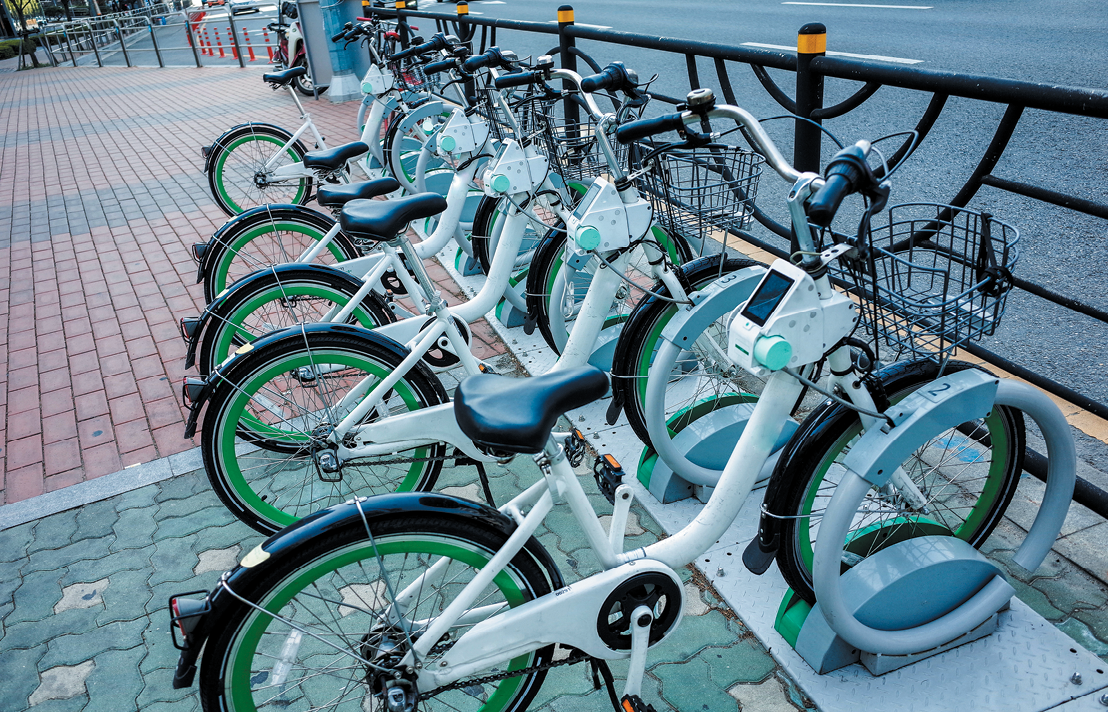
Although I can see the appeal of a folding bicycle, they don’t pack much smaller than my 22-pound Fuji, and they are not nearly as fun to ride. I’ve never had trouble finding room for my Fuji on the boat. The wheels easily pop off. I turn the handlebars 90 degrees and stuff it down the hatch. On a boat with even less room, the wheels and frame can be stowed in separate lockers.
The best thing you can do before investing in any of these bikes is to try them out. For this report, I found no shortage of strangers on local bike paths who were happy to talk about their bikes and let me put them through their paces. Each style has their own attraction, and your preferences may be different than mine. Different spokes for different folks, so to speak.
CONTACTS
AVENTON, aventon.com
BAFANG, bafang-e.cn/en
BOSCH, bosch-ebike.com
DAHON, usa.dahon.com
JACKRABBIT, jackrabbit.bike
JUPITER, jupiterbike.com
MONTAGUE, montaguebikes.com
PEDEGO, pedegoelectricbikes.com
QUALISPORTS, qualisports.us
VELOTRIC, www.velotricbike.com
ZIZZO, www.westsystem.com
Materials, construction quality, and components are quite similar among brands, but there is a greater variety in the design details.
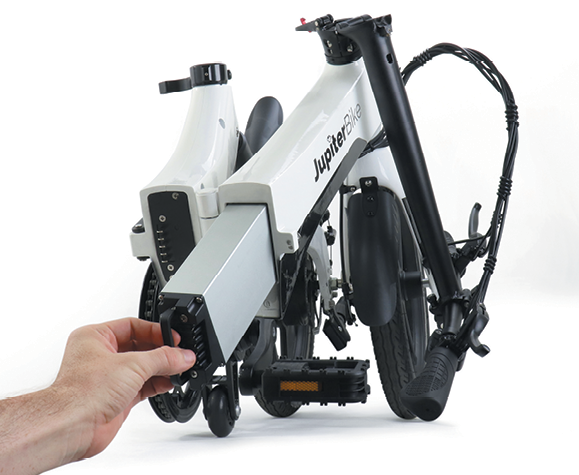
1. The Jupiter Discovery X-5 achieved a compact size when folded in part because of the 16-inch wheel size. The 5Ah lithium battery slides inside the frame.
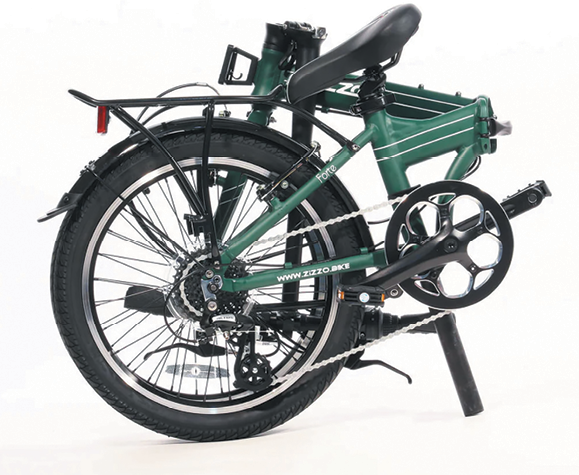
2. The Zizzo Forté folding bike is heavily reinforced to carry loads up to 300 pounds, the largest payload among our folding bikes. An electric version is also available.
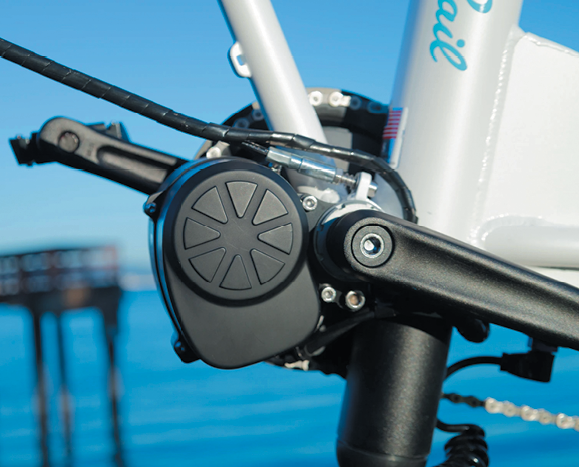
3. Some makers, like Dahon, offer both mid-drive (shown here) and a less expensive hub drive version. The Dahon mid-drive model, the Unio E20, costs about $900 more than the hub drive K-1 we tested.

4. The Aventon Sinch.2 features integrated brake lights with turn signal functions.

5. The Bafang hub drive can be fitted to a variety of bikes, but will cost nearly as much as a complete e-bike.
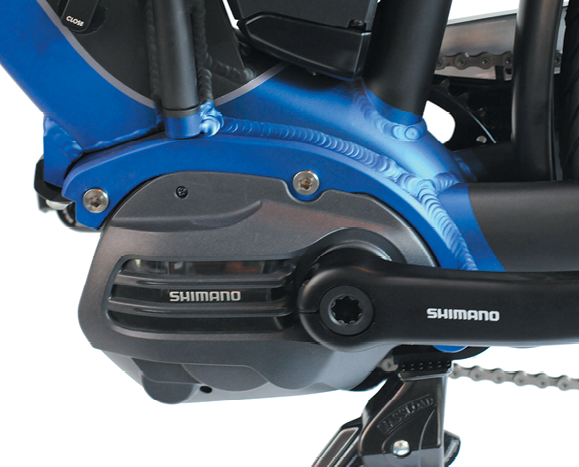
6. The Shimano E6100 mid-drive system gave the Montague MT-1 the look and feel of a well-balanced, full-size bike.

VALUE GUIDE: EBIKES FOR BOATS
| BRAND | WATTS | BATTERY AH | DRIVE | VOLTS | WATT-HOURS | WEIGHT (pounds) | WHEEL SIZE | FOLDED SIZE (inches, HxLxD) | CLASS | COST |
|---|---|---|---|---|---|---|---|---|---|---|
| Standard bike | ||||||||||
| Fuji ✔ | NA | NA | NA | NA | NA | 22 | 700c | 34x47x12 | NA | $999 |
| Folding bike | ||||||||||
| Dahon Mariner D-8 ✔ | NA | NA | NA | NA | NA | 28 | 20 in. | 25x31x12 | NA | $950 |
| Zizzo Liberte $$ | NA | NA | NA | NA | NA | 23 | 20 in. | 27x31x12.5 | NA | $479 |
| Conversion kit | ||||||||||
| Bafang Rear Hub ✔ $$ | 500 | 17 | Hub | 48 | 816 | 21 + bike | 20, 24, 26 in. & 700c | NA | 3 | $425 |
| Bosch Trike Boost | 500 | 8.3 | Mid-drive | 48 | 400 | 18 + bike | 20 in. | NA | 1 | $2,850 |
| Zizzo | 350 | 12 | Hub | 36 | 432 | 18 + bike | 20 in. | NA | 2 | $499 |
| Folding e-bikes | ||||||||||
| Dahon K-1 ✔ | 250 | 8.7 | Mid-drive | 36 | 313 | 42 | 16 in. | 26x33x15 | 2 | $1,650 |
| Montague MT-1 ✔ | 250 | 14 | Mid-drive | 36 | 518 | 54 | 700c | 28x36x12 | 1 | $3,995 |
| Pedego Latch | 500 | 11 | Hub | 52 | 546 | 56 | 20 in. | 28x34x15 | 2 | $2,795 |
| Aventon Sinch.2 | 500 | 14 | Hub | 48 | 672 | 68 | 20 in. | 30x46x28 | 2 | $1,300 |
| Jupiter Discovery X-5 | 350 | 5.2 | Hub | 36 | 187 | 40 | 16 in. | 30x21x15 | 2 | $1,000 |
| Qualisports Volador | 350 | 7 | Hub | 36 | 252 | 38 | 20 in. | 26x33x16 | 2 | $1,200 |
| Zizzo eForte $$ | 350 | 7 | Hub | 36 | 252 | 41.5 | 20 in. | 27x31x12.5 | 2 | $999 |
| Standard e-bike and push bike | ||||||||||
| Velotric T1ST ✔ | 350 | 9.8 | hub | 36 | 353 | 36 | 700c | 34x60x28 | 1 | $999 |
| Jackrabbit OG | 300 | 4.2 | hub | 36 | 151.2 | 24 | 20 in. | 31x50x7 | 4 | $999 |







































